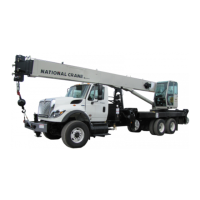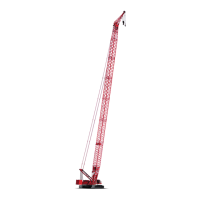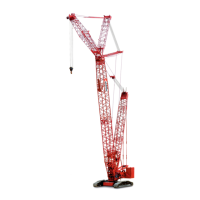HYDRAULIC SYSTEM 14000 SERVICE MANUAL
2-32
Published 09-05-14, Control # 226-02
Pressure Sender Replacement
Hydraulic pressure senders monitor system pressure in each
hydraulic system and are located near each system motor.
Follow steps below to replace a faulty pressure sender.
1. Lower all loads to ground.
2. Move all control handles to off and park all crane
functions.
3. Stop engine.
4. Place a suitable container under faulty pressure senders
to catch oil leakage.
Perform steps 5
– 9 only at faulty pressure sender.
5. Disconnect electrical (DIN) connector from pressure
sender.
6. Slowly loosen pressure sender only enough to allow
any remaining pressure to exhaust.
7. Remove pressure sender.
8. Install new pressure sender and connect electrical (DIN)
connector.
Pressure senders have pipe threads. Be sure to install
thread sealant.
9. Bleed pressure senders, as follows:
a. Connect bleed line with a shut-off valve to coupler
on pressure sender manifold. Open shut-off valve.
Use a suitable container to catch oil flow.
b. With all control handles off, start and run engine at
low idle.
c. Observe oil flowing from bleed line.
d. Close shut-off valve when clear oil flows from bleed
lines (no air bubbles in oil).
e. Stop engine.
f. Remove bleed line from coupler at pressure sender.
10. Test pressure sender (see procedure in this section).
Disc Brake Operational Test
There is no physical way to check the disc brakes for travel,
boom hoist, load drums, and swing. An operational test of
each brake must be performed weekly. Figure 2-13
shows
brake and brake solenoid valve locations.
NOTE: See Table 2-10
system pressure specifications.
The electrical (DIN) connectors must be
disconnected at the brake solenoid valves to stall
the crane functions during the test.
1. Disconnect electrical (DIN) connector for brake being
checked.
2. Start and run engine at low idle.
3. Select corresponding Liftcrane Boom Capacity Chart on
Rated Capacity Indicator/Limiter screen.
4. Turn off park switch on control console for function being
checked.
5. Access diagnostic screen (Figure 2-15
) for function
being checked – Drum, Boom Hoist, Swing, or Travel.
NOTE: For front or rear load drum, make sure free fall is
Off.
Monitor system pressure and pump command while
moving control handle.
6. Slowly move control handle for function being checked.
Specified system pressure must be reached before 50%
pump command is reached and brake must not slip.
7. Repeat steps or each function.
8. Reconnect electrical (DIN) connectors to all brake
solenoid valves at completion of operational test.
9. If disc brakes were repaired or replaced, retest brakes
before operating with a load.
WARNING
High Pressure Oil Hazard
Do not attempt to remove a pressure sender unless
following steps are performed. High pressure oil will
exhaust from pressure sender ports.
CAUTION
Overheating Hazard
Do not hold any function on stall for more than 5 seconds.
Damage from overheating can occur to system
components.
WARNING
Falling Load/Moving Crane Hazard
If a disc brake slips when operational test is performed,
repair or replace it before placing crane back into service.
Loads could fall or crane could move if brakes are not
operating properly.
See gearbox manufacturer’s manual for disc brake repair
instructions.

